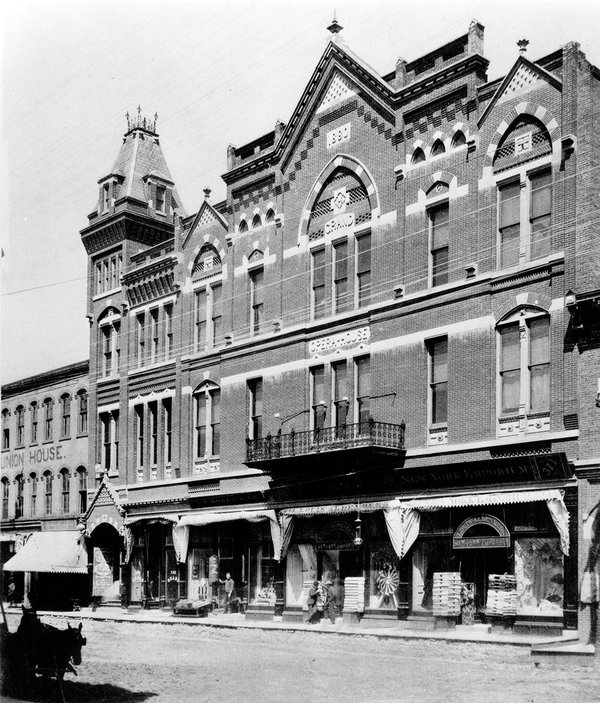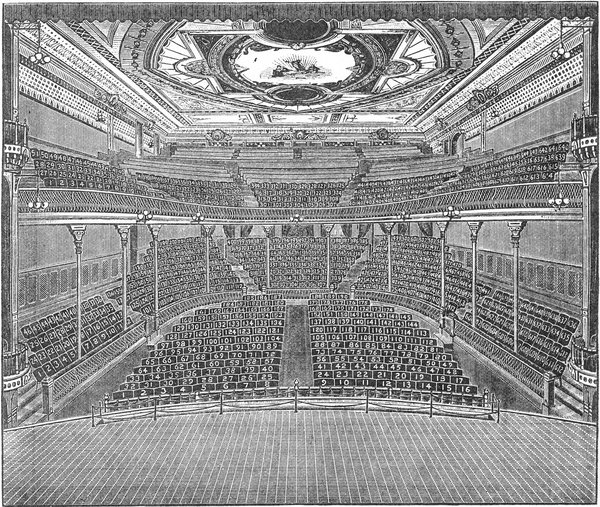Grand Opera House
By the 1870s, Stillwater was a prosperous boom town with numerous modern buildings, but could not boast of an elegant opera house like those seen in older cities. That would soon change.
Construction began on the Grand Opera House in August 1879. The famous Minnesota architect, A.M. Radcliff, who had earlier designed the Isaac Staples Mansion, designed it. The opera house building fronted Main Street and was 120 feet deep. The entire cost of the building was $75,000, and taking less than two years to complete.
At the street level there were four large stores, all with plate glass windows. The trim of the building was made of Kasota stone and the main entrance was at the northwest corner of the building. Then there was a 10-foot wide staircase that led to the second floor and to the ticket booths.
The seating capacity was 1,217. On the ceiling was a beautiful painting representing the genius of the fine arts, and in the center was a group of six figures that represented Poetry, Painting, Architecture, Sculpture, Music and Drama.
On Wednesday evening May 11, 1881 a capacity crowd entered the new Opera House to see the opening night play, "Salsbury's Troubadours in 'The Brook.'" In the program the proprietors and Managers: L.E. Torinus, E.W. Durant, R.J. Wheeler, and A.T. Jenks, wrote: "The proprietors of the Grand Opera House present their compliments to the Citizens of Stillwater and take great pleasure in announcing to the public the completion of a Theatre in this city second to none west of New York City. The Theatre has been built and fitted up with a view of making it the most elegant place of amusement in our state." Ticket prices for that first performance ranged from 50 cents to $100.
Many of the best plays and operas of the day would make Stillwater's Grand Opera House a stop on their tours. On September 26, 1881, Buffalo Bill and his wild west show put on a performance of "Prairie Waif! A Story of the Far West" at the opera house. In 1883 and again in 1886, bare knuckle boxing champion John L. Sullivan put on exhibitions there and on March 19, 1902, John Philip Sousa's band played there.
Fire was always a concern in the early days of Stillwater. In October 1893 the Stillwater Messenger published an article about the new fire prevention measures put into the Opera House. “On each side of the stage are water connections,” the article wrote, “and beside which hangs the stage hose. There is a great water pressure here and the stage could be flooded in a very few seconds should the emergency arise.” According to Manager Edward Durant, “it’s a clumsy plaything [the hose] but when it’s needed, it is needed mighty bad.”
On the morning of December 5, 1902, Durant’s clumsy plaything was needed as the building caught fire. By the time the fire was noticed, the fire prevention equipment installed less than 10 years earlier proved useless. Flames were soon shooting from the roof. A desperate call was made to the St. Paul Fire Department for help, but by the time they arrived, the fire had done its damage. It was presumed that the fire started under the stage in the property room where a man named Nicholas Clark was sleeping. At first it was thought he died in the fire, but did get out when the fire was discovered. The roof and walls of the opera house collapsed, creating a great noise throughout the valley, and then the tower and front wall collapsed on to Main Street. The Union Block, directly across the street, suffered damage from the heat, which cracked the plate glass windows into little bits.
The total damage to the opera house and several neighboring buildings was estimated at between $150,000 to $200,000. Later the remains of the building was cleared away and the Simonet Company purchased the site. There, the Simonets constructed another building for their store which opened in 1904. After decades downtown, Simonets moved and the old store is now Mid-Town Antiques.
—Brent Peterson
Brent Peterson is the Executive Director of the Washington County Historical Society.


